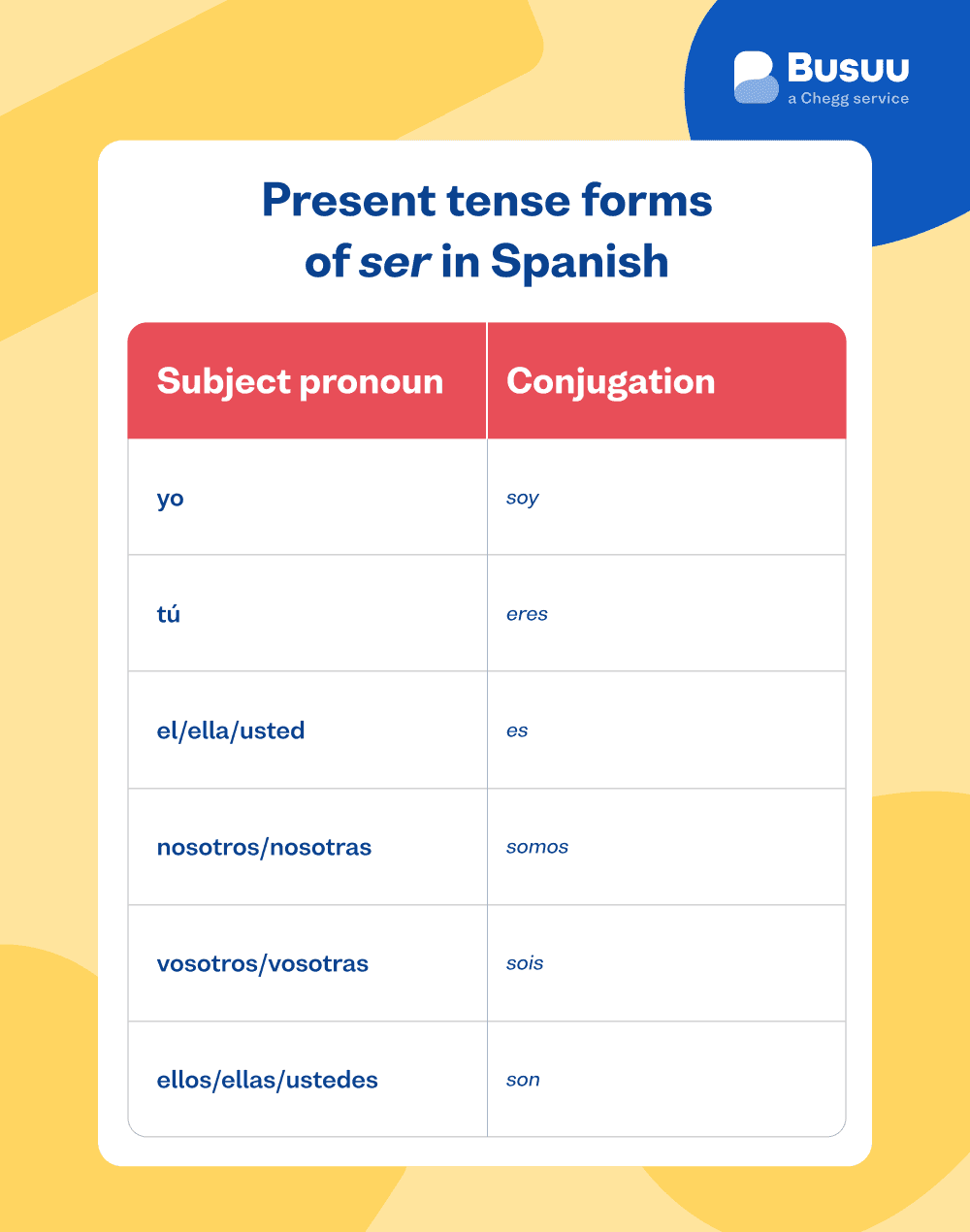I want to learn...
You find yourself at a work event in Spain and someone comes up to introduce themselves. They ask who you are and what you do. How can you respond? We use the verb ser (to be) in Spanish to introduce ourselves and our jobs, for example.
Here, we’ll look at this essential verb, learn how to conjugate it, and see how we use it to talk about ourselves and others using subject pronouns and adjectives.
Ser in Spanish: Present tense conjugation
Before we dive into the many uses of ser, let’s look at how we conjugate this verb. Because this verb is irregular, knowing the different forms of ser in Spanish will help you recognize it in example sentences.
While it will be useful throughout your Spanish learning journey to know several different verb tenses for ser, in this article, we’ll just stick with the present tense.

Present tense forms of ser in Spanish
| Subject pronoun | Conjugation |
|---|---|
| yo | soy |
| tú | eres |
| el/ella/usted | es |
| nosotros/nosotras | somos |
| vosotros/vosotras | sois |
| ellos/ellas/ustedes | son |
Note: Vosotros/vosotras is mainly used in Spain and not in Latin America, where it is more common to use the polite form usted/ustedes instead.
Here are some examples of sentences using
Ella es de Argentina.
She is from Argentina.Somos estudiantes.
We are students.Mañana es el concierto.
Tomorrow is the concert.
The many uses of ser in Spanish
Like the other Spanish verb for “to be” ( estar), ser has its own special set of uses. An easy way to remember them is by using the acronym D.O.C.T.O.R..
Let’s break it down a bit:
D– description: describing permanent characteristics of a person, thing, or idea.
O– occupation: talking about someone’s job or professions.
C– characteristic: describing a person’s or thing’s inherent qualities.
T– time: expressing the time of day, day of the week, date, or events.
O– origin: saying where someone or something is from.
R– relationship: expressing how two people are related.
Here are some examples of the diverse uses of the verb '
Los vestidos son rojos.
The dresses are red.Él es médico.
He is a doctor.Mi hermana es inteligente.
My sister is intelligentHoy es jueves.
Today is Thursday.Ellos son mis amigos.
They are my friends.
Now that we’ve reviewed the diverse uses of the verb ser, let’s look at how we can use ser with adjectives.
Ser+ an adjective
In Spanish, it is important for adjectives to match with their subjects in number and gender. This is also the case when using adjectives with the verb ser (to be).
We can see in the above examples that the adjectives match their subjects. Take a look at the example: Losvestidossonrojos. (The dresses are red.)
In this example, we add an -s to rojo (red) to make sure that it reflects that there is more than one dress that is red.
Here are some more examples:
Ellas son inteligentes.
They are intelligent.Ella es simpática.
She is friendly.Ustedes son trabajadoras.
You all are hardworking.
The fact that adjectives and subjects must agree in Spanish is handy in many ways. In some situations, it even helps us out when we drop our subject pronouns. Let’s see what that looks like when we use the verb ser (to be).
Ser + subject pronouns
As with other verbs in Spanish, it isn’t always necessary to use a subject pronoun when using the verbser. This is because the forms of the verb ser tell us which subject pronoun they are associated with.
Combine this with Spanish’s subject + adjective agreement rules, and it’s easy (and very normal) to drop your subject pronouns.
If we seesomos simpáticas(we are friendly / nice), we know that the subject pronoun is nosotras because of somos (the present tense nosotros / nosotras version of ser) and also because of simpáticas (the adjective meaning friendly / nice, which in this sentence indicates both female and plural).
It’s important to note that while we can often drop our subject pronouns, we need to make sure that the sentence has enough context.
If the listener can’t figure out the subject from the conversation’s context, or if you need to emphasize the subject, make sure that you include the subject pronoun.
Understandingser vs.estar
As we mentioned earlier, both ser and estar mean “to be” in Spanish, and their uses are often confused by beginner Spanish speakers.
Let’s clarify their uses here.
We use estar to talk about temporary states, conditions or characteristics, and feelings and emotions.
Ser, on the other hand, as you now know, is used for more permanent or inherent characteristics such as nationality, physical appearance, or occupation. We also use it for the time, dates, and to indicate ownership.
Take a look at the following sentences:
I am really sick.
It’s her house.
I am in Dallas.
We are very smart.
You (plural) are so excited!
Based on what you know about ser and estar, in which sentences would you use ser?
If you only choose 2 and 4, you are correct.
Let’s look at these five sentences in Spanish:
Estoy muy enfermo/enferma. (note the use of estar)
I am really sick.Es su casa.
It’s her house.Estoy en Dallas. (note the use of estar)
I am in Dallas.Somos muy inteligentes.
We are very smart.¡Estáis muy emocionados/emocionadas! (note the use of estar)
You (plural) are so excited!
Sometimes, there may be a slight difference in meaning when using the verb ser versus estar in the same sentence.
For example:
Tu nueva amiga es aburrida / Tu nueva amiga está aburrida.
Your new friend is boring / Your new friend is bored.María es muy orgullosa / María está muy orgullosa.
María is very vain / María is very proud.Pablo es muy molesto / Pablo está muy molesto.
Pablo is very annoying / Pablo is very annoyed.
Did you notice the subject-verb agreement in these sentences? Did you also notice how subject pronouns were dropped?
Wrapping up
Now you’ve seen how and when we use the irregular verb ser(to be) and have learned how to conjugate it in the present tense.
This verb is quite common and is used for all sorts of things from saying the time, talking about personality traits and jobs, and indicating ownership.
You’ve also seen the importance of subject + adjective agreement in number and gender and that, in many cases, we can drop the subject pronoun in sentences using ser.
You’re now ready to start using ser in your daily Spanish practice!
Newlanguages


